Skip to content 
Wood, Wire, Wings: Emma Lilian Todd Invents An Airplane
By Kirsten W. Larson, Illustrated by Tracy Subisak
Emma Lilian Todd’s mind was always soaring–she loved to solve problems. Lilian tinkered and fiddled with all sorts of objects, turning dreams into useful inventions. As a child, she took apart and reassembled clocks to figure out how they worked. As an adult, typing up patents at the U.S. Patent Office, Lilian built the inventions in her mind, including many designs for flying machines. However, they all seemed too impractical. Lilian knew she could design one that worked. She took inspiration from both nature and her many failures, driving herself to perfect the design that would eventually successfully fly. Illustrator Tracy Subisak’s art brings to life author Kirsten W. Larson’s story of this little-known but important engineer. 7-10 years
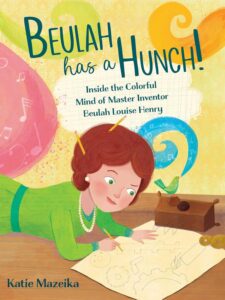
Beulah Has a Hunch: Inside the Colorful Mind of Master Inventor Beulah Louise Henry
By Katie Mazeika
Growing up in the 1890s, when Beulah Louise Henry spotted a problem, she had to find a solution, turning it around and around in her mind until…aha! She had a hunch—what she called the inventions she came up with to solve the puzzles she saw all around her.
Beulah’s brain worked differently. She had hyperphantasia, which meant she saw things in extreme detail in her mind, as well as synesthesia, which caused words and numbers and even music notes to show up as different colors in her brain. Beulah’s unique way of seeing the world helped her think up vivid solutions to problems—her hunches came to her fully formed with gears whirring and wheels spinning. She invented everything from a new and improved parasol to cuddly stuffed animals and from ice cream makers to factory machinery. Beulah’s inventions improved daily life in lots of ways, earning her the nickname “Lady Edison,” and she became one of the most prolific inventors in American history. 4-8 years

Sweet Dreams, Sarah
By Vivian Kirkfield, Illustrated by Chris Ewald
Sarah E. Goode was one of the first African-American women to get a US patent. Working in her furniture store, she recognized a need for a multi-use bed and through hard work, ingenuity, and determination, invented her unique cupboard bed. She built more than a piece of furniture. She built a life far away from slavery, a life where her sweet dreams could come true. 7-11 years

Hedy Lamarr’s Double Life: Hollywood Legend and Brilliant Inventor
By Laurie Wallmark, Illustrated by Katy Wu
Movie star by day, ace inventor at night: learn about the hidden life of actress Hedy Lamarr! To her adoring public, Hedy Lamarr was a glamorous movie star, widely considered the most beautiful woman in the world. But in private, she was something more: a brilliant inventor. And for many years only her closest friends knew her secret.
Now Laurie Wallmark and Katy Wu tell the inspiring story of how, during World War Two, Lamarr developed a groundbreaking communications system that still remains essential to the security of today’s technology. 5 years+
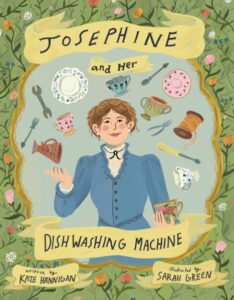
Josephine and Her Dishwashing Machine: Josephine Cochrane’s Bright Invention Makes a Splash
By Kate Hannigan, Illustrated by Sarah Green
Meet Josephine Garis Cochrane: entrepreneur, innovator, girl boss. Washing dishes is a pain—it leaves Josephine’s cups cracked, her dishes dinged, and her chowder bowls chipped. She’d rather be picking flowers, frosting cakes, or playing piano than dealing with cracked crockery. What to do about a chore that’s icky, destructive, and time-consuming? Josephine tackles this task the modern way: she makes a machine to do it for her! She tinkers and tests, and perseveres through fizzles and flops—until she has a government patent for her invention, and there are whirring, whizzing, bubbling dishwashers making a splash across America. 7-10 years
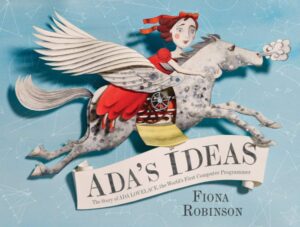
Ada’s Ideas: The Story of Ada Lovelace, the World’s First Computer Programmer
By Fiona Robinson
Ada Lovelace was the daughter of Lord Byron, a poet, and Anna Isabella Milbanke, a mathematician. Her parents separated when she was young, and her mother insisted on a logic-focused education, rejecting Byron’s “mad” love of poetry. But Ada remained fascinated with her father and considered mathematics “poetical science.” Via her friendship with inventor Charles Babbage, she became involved in “programming” his Analytical Engine, a precursor to the computer, thus becoming the world’s first computer programmer. This picture book biography of Ada Lovelace is a compelling portrait of a woman who saw the potential for numbers to make art. 6-9 years
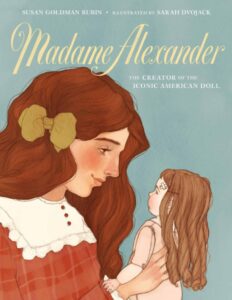
Madame Alexander: The Creator of the Iconic American Doll
By Susan Goldman Rubin, Illustrated by Sarah Dvojack
Beatrice Alexander’s family ran a doll hospital in their home in New York’s Lower East Side, where she grew to love fixing and making dolls. Beatrice dreamed of becoming an artist, but her family couldn’t afford to send her to sculpting school. She never stopped dreaming, even as she stayed home, graduated from high school, and got married. When World War I broke out, she came up with the idea to make unbreakable, cloth dolls modeled after nurses to support the war effort and help keep children happy. After the war, Beatrice founded Madame Alexander and redefined the doll industry, creating some of the first plastic and collectible dolls, dolls that never break. 3-6 years
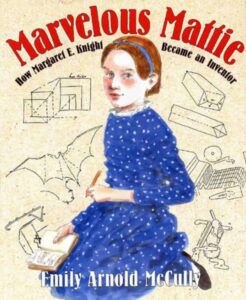
Marvelous Mattie: How Margaret E. Knight Became An Inventor
by Emily Arnold McCully
With her sketchbook labeled My Inventions and her father’s toolbox, Mattie could make almost anything — toys, sleds, and a foot warmer. When she was just twelve years old, Mattie designed a metal guard to prevent shuttles from shooting off textile looms and injuring workers. As an adult, Mattie invented the machine that makes the square-bottom paper bags we still use today. 7-11 years

Girls Think of Everything: Stories of Ingenious Inventions by Women
By Catherine Thimmesh, Illustrated by Melissa Sweet
In kitchens and living rooms, in garages and labs and basements, even in converted chicken coops, women and girls have invented ingenious innovations that have made our lives simpler and better. What inspired these girls, and just how did they turn their ideas into realities? This updated edition of the best-selling Girls Think of Everything features seven new chapters that represent our diverse and increasingly technological world, offering readers stories about inventions that are full of hope and vitality—empowering them to think big, especially in the face of adversity. 8-11 years
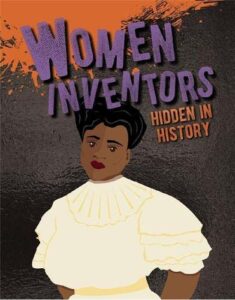
Women Inventors Hidden in History
By Petrice Custance
We’ve all heard of Alexander Graham Bell and Thomas Edison, but very few female inventors are household names. This fascinating book illuminates the history of women who used their brainpower and skills to produce important items we use ever day. Meet Hedy Lamarr, a famous Hollywood actress by day and inventor of a radio guidance system for torpedos by night. Marvel at the cleverness of Ng Mui, who developed the martial art known as Wing Chun, which later evolved into kung fu. 10-13 years

Brilliant Ideas From Wonderful Women: 15 Incredible Inventions From Inspiring Women
By Aitziber Lopez, Illustrated by Luciano Lozano
Car heaters…Monopoly…Disposable diapers…The dishwasher…Kevlar…Maritime flares… Anti-reflective glass…Wifi…Syringes…Submarine periscopes…Diagnostic tests…Lifeboats…Windshield wipers…Ebooks…What do each of these revolutionary inventions have in common? They were all pioneered by women!
Each brilliant idea is presented with biographical information about the woman who came up with it, including what inspired them. Learn how Martha Coston disguised herself as a man to contact pyrotechnicians and convince them to manufacture her idea for maritime flares, how a New York tram ride on a wet winter’s day led Mary Anderson to invent the windshield wiper, and why Letitia Mumford Geer’s one-hand operated syringe was a medical breakthrough, among many other fascinating facts. 5-7 years
The book descriptions are primarily from the publishers.
If you like this post, then please consider sharing it and/or leaving a comment below. Thank you! Barbara Lowell, Children’s Author
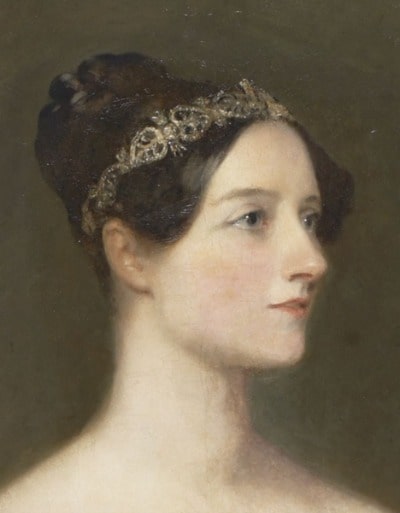
Ada Lovelace is considered to be the world’s first computer programmer.
Ada was born in England on December 10, 1815, the daughter of the famous and reckless poet Lord Byron. Soon after she was born, her parent’s marriage ended. Ada never saw her father again.
Her mother, Anne Isabella Milbanke had a great interest in mathematics. Byron called her the Princess of Parallelograms. Anne Isabella steered her daughter away from poetry and into mathematics and science.
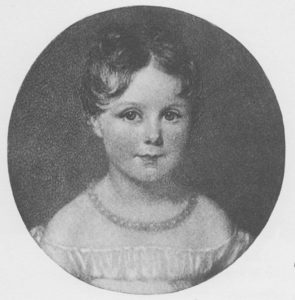
Ada Lovelace
Ada had a wonderful imagination. She decided that she would learn how to fly by studying birds’ anatomy. Ada made a set of wings. She wrote and illustrated her own book called Flyology and designed a flying mechanical horse.

Lord Byron
In 1829, Ada became temporarily paralyzed after having measles. She improved her math and science skills while bedridden. At age sixteen, restored to health, Ada was introduced to English society. She met famous scientists and became friends with the engineer Charles Babbage.
Babbage invented a machine called the Difference Engine. It worked like a giant calculator. He then designed a more complex machine he called the Analytical Engine. Babbage thought it would solve difficult mathematical calculations. The machine would then store these calculations. And it would also print them.
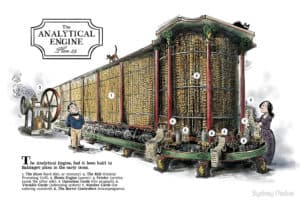
The Analytical Engine
Ada translated an article written about the Analytical Engine into English. She added her own notes. These notes contained an algorithm that would allow the machine to work. Ada’s algorithm is considered to be the first computer program.
The Analytical Engine was too expensive to build. But it is considered to be the first computer. And Charles Babbage is acknowledged as the “father of the computer.”
Charles Babbage designed his Analytical Engine to be capable of working with numbers. But Ada thought the machine had much greater possibilities. She envisioned it producing music, art, and writing, like modern computers.
Sadly, Ada died at age 36. Although she never met her father, she requested to be buried next to his grave in England.
If you like this post, then please consider sharing it and leaving a comment below. Thank you! Barbara Lowell
Books For Kids About Ada Lovelace:
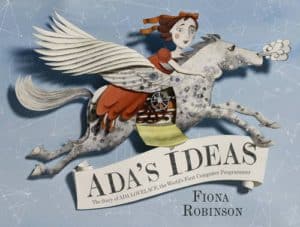
Ada’s Ideas: The Story of Ada Lovelace,
the World’s First Computer Programmer
by Fiona Robinson
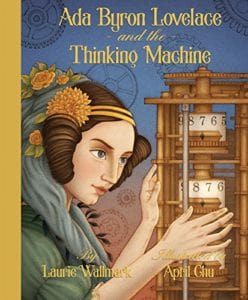
Ada Byron Lovelace and the Thinking Machine
by Laurie Wallmark, Illustrated by April Chu

Ada Lovelace Poet of Science
by Diane Stanley, Illustrated by Jessie Hartland
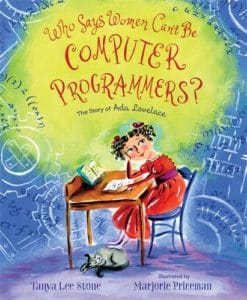
Who Says Women Can’t Be Computer Programmers?
The Story of Ada Lovelace
By Tanya Lee Stone, Illustrated by Marjorie Priceman


















